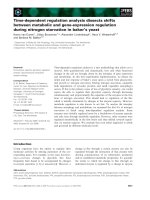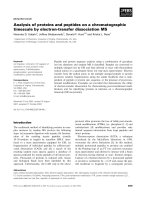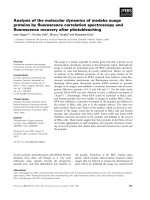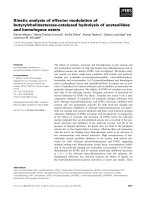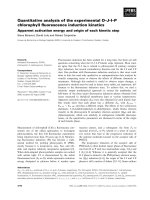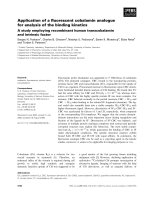Tài liệu Báo cáo khoa học: "Contextual Analysis" doc
Bạn đang xem bản rút gọn của tài liệu. Xem và tải ngay bản đầy đủ của tài liệu tại đây (172.26 KB, 6 trang )
[
Mechanical Translation
, vol.4, no.3, December 1957; pp. 70-75]
Contextual Analysis
Kenneth E. Harper, University of California, Los Angeles, California
Ambiguity, both syntactic and semantic, a problem that arises in the translation of
Russian to English because of polysemantic forms in Russian, can be resolved by
an analysis of the context in which the polysemantic form occurs. This requires a
systematic study of context so that word classes which determine the value of am-
biguous forms can be established.
IN THE VARIOUS PROPOSALS for word-for-
word machine translation of Russian scientific
literature into English, each word in the sen-
tence is considered as a separate entity. If a
word has more than one English equivalent, or
more than one possible syntactic value, the al-
ternatives must be listed. The chief difficulty
with the resulting translation is its prolixity:
the reader finds himself confronted with nu-
merous alternatives, both syntactic and seman-
tic, in every sentence. The extent of the prob-
lem of ambiguity is suggested by the following
figures: from a sample Russian scientific text,
43% of the running words were found to be poly-
semantic (this in addition to syntactic ambigu-
ities which the reader must solve on the basis
of numerous alternatives given him in every
sentence).
Сontext
The difficulty with word-for-word translation,
then, is that it is really "words-for-word
translation".
1
The solution to the problem
lies in the reduction of the number of choices
1. The problem of word order is not critical
in MT, particularly for technical material.
Even in the general literary language, the word
order, subject-verb-direct object, is preserved
in 85 - 90% of all sentences (according to a
study of 5000 pages of Russian prose text,
cited in Voprosy grammaticheskogo stroya,
Izdatel'stvo Akademii Nauk SSSR, Moscow,
1955, p. 471).
confronting the reader by the mechanical selec-
tion of the proper (or actual) syntactical and
semantic equivalent from the various potential
equivalents. Obviously, the solution can be
attempted along lines as infinitely complex as
those involved in "human translation", in which
judgments are based on "context", experience
and even upon "taste". Of these the element of
"context" is, to some degree, determinable by
mechanical means. In its general sense, con-
text signifies environment, i.e., surrounding
words in a sentence, surrounding sentences
and paragraphs, extending to the broad cate-
gory of subject areas. The question arises:
Is some more limited use of context analysis
possible in MT, and how effective is such anal-
ysis in the removal of ambiguity?
In an attempt to answer this question, the
potentialities of a "contextual analysis" of
each ambiguous word (syntactically or seman-
tically ambiguous) have been studied, such
analysis to be limited to immediately contiguous
words. Thus, for a given ambiguous word (x),
reference may be made to the preceding word
(x-1) or to the following word (x+1). (In speci-
fied instances, reference may be made to words
which are separated by neutral words from
(x) word.)
The value of this limited contextual analysis
was suggested by the inflectional nature of the
Russian language. For example, the English
preposition, 'of, indicating possession, does
not have a "word equivalent" in Russian; the
'of' is generated by the genitive case of the
noun or pronoun (добавление смеси = 'the ad-
dition of the mixture'). Two difficulties arise
Contextual Analysis 71
in straight word-for-word MT: 1) difficulty
of identifying the genitive ending for most
nouns, so that the above Russian words may
theoretically mean 'the addition to
the mixture',
'the addition the mixture', or 'the addition the
mixtures', as well as the translation given
above; 2) the 'of generated by the genitive
case is often disregarded, under the condition,
for example, that the word is preceded by a
preposition which governs the genitive case.
The task of deciding whether or not to retain
the 'of' falls upon the reader. The problem
results, of course, from the syntactical com-
pactness of inflected languages. Since syntac-
tical information in Russian is contained not in
discrete items (individual inflected words), but
in the relationship between words, a compari-
son process is imperative.
A second reason for believing in the potential
of contextual analysis is the effect that consid-
eration of immediately contiguous words has
upon the removal of semantic ambiguity of a
given word. Professor Kaplan's study on this
problem suggests that a marked reduction of
ambiguity is the result of considering one or
two words preceding and following the ambig-
uous English word.
2
This is a completely-
virgin field of investigation, but preliminary
studies indicate that within a closed area of
discourse, such as Russian technical literature,
the problem of multiple meaning can be satis-
factorily handled through the analysis of contig-
uous words.
In the two following sections studies on the
effect of syntactic and semantic clarification
bу this method are summarized.
Clarification of Syntax
It is essential in this system that any given
word in a Russian sentence be subject to reten-
:ion and further inspection; in other words,
location of the item in the memory is only (or
nay be only) half the job. Even after its gram-
matical features have been determined, whether
in a paradigm or stem-affix machine dictionary,
:he word is not to be printed by the output de-
n.ce until a "go ahead" signal is given. In
theory, every word in a sentence is potentially
useful to a contiguous word; every word is a
2. Kaplan, Abraham, "An Experimental Study
of Ambiguity and Context", Mechanical Trans-
lation, vol. 2, no. 2, pp. 39-46, November 1956.
potential determiner, and, if it is in any way
ambiguous, a potential determinee. Our prob-
lem is to discover the manner in which this
relationship is expressed, and to represent it
in codable form. In certain instances, as in
the relationship between adjective and noun,
for example, the mutual influence is recogniz-
able in terms of conventional grammar; more
frequently, the relationship is unpredictable
and must be discovered by observation of be-
havior in a large number of situations. In any
event, the ability to make reference to words
in immediate contiguity is inherent to this
system.
For purposes of syntactical clarification,
conventional grammatical concepts are quite
useful. It is helpful, for instance, to have
available, in coded form, the following infor-
mation for words in a Russian sentence: part
of speech of all words; case, number, and
gender of nouns; the infinitive form and tense
of verbs; case and number of certain adjec-
tives, etc. Reference to this information may
be helpful in contextual analysis. It should be
stressed that reference is made to these coded
features, rather than to "the word" itself. In
the latter process, we become involved in the
identification of idioms, i.e., in the problem
of lexical relationship; our present interest is
in the structural relationship and its effect upon
clarification of syntax.
The processing of syntactically ambiguous
words may be summarized in the following de-
scriptive terms:
1) Nouns
a) Genitive Case
For masculine nouns, this case is iden-
tifiable by ending (disregarding, in technical
Russian, the almost non-existent animate noun).
For all neuter and feminine nouns, this case is
ambiguous by ending in the singular. For all
unmodified nouns which are definitely or poten-
tially genitive case, by ending, the English
preposition 'of' is generated only under the con-
dition that the preceding word is a noun. The
'of' is to precede the noun identified as genitive;
if adjectives precede the noun in question, the
'of' is to precede all such modifiers. In refer-
ring to the part of speech of the preceding word,
modifiers of the word in question are ignored.
добавление смеси
= 'addition (of) the mixture'
добавление этой смеси
= 'addition (of) this mixture'
72 К. Е. Harper
The result of the above restriction (that the
preceding word must be a noun) automatically
eliminates the generation of the 'of' in the fre-
quent instances where the genitive case is re-
quired by Russian grammatical rules, but
where its identification only serves to hinder
the translation, — for example, when the pre-
ceding word is: a preposition, a cardinal num-
ber, a comparative adjective, a negative (нет),
a verb which governs the genitive case, words
of quantity (много, сколько), negated verb, etc.
This rule, formulated purely on the basis of
observed behavior, very accurately approxi-
mates the control over "context" unconsciously
enjoyed by the human reader of Russian.
b) Instrumental Case
This case is not ambiguous by ending.
Nouns in this case (and any preceding modifiers)
are to be preceded by the English word 'by'
('with' in certain specified cases), except when
the preceding word is a preposition, or a verb
governing the instrumental case (which may
also follow the noun).
c) Dative Case
This case may be ignored, since the gen-
eration of the English 'to' can be most econom-
ically handled in the dictionary listing of the
manageable number of words which precede
nouns in this case.
d) Nominative, Accusative, and
Prepositional Cases
These may be ignored because of the
factor of word order.
e) Number in Nouns
The plural number of all nouns is unam-
biguous, with the exception of neuter and fem-
inine nouns in the nominative and accusative
plural (where they are identical with the geni-
tive singular). If these ambiguous forms have
been identified as genitive (under la above),
they may be automatically identified as singular
also. In all other instances, the number of
such forms can be satisfactorily determined
by reference to the preceding word. The ad-
jective and (in almost all instances) the prepo-
sition are absolute determiners of number;
other forms which require the noun in the geni-
tive case may also be utilized to determine the
singular number of the ambiguous form (in in-
stances where the English 'of' is not generated);
the absence of these conditions, or the pres-
ence of a period or a comma in the preceding
position, may be taken as an indication that the
form is plural in number.
2) Adjectives
Often adjectives are useful in determining
the case and number of nouns; otherwise, they
may be ignored as to agreement with noun.
a) Short adjectives, singular, (in -zero,
-a, -о) are to be preceded by the word "(is)"
in translation; short adjectives, plural, (in -ы
or-и) are to be preceded by "(are)". These
English words are, further, to precede an ad-
verb which may precede the short adjective.
Если температура очень высока
If the temperature (is) very high
b) Comparative adjectives: the word 'than'
will be inserted in the translation if the follow-
ing word is a noun.
3) Adverbs
The distinction between a short neuter ad-
jective and an adverb is apparently impossible
to make, since the forms are identical. Pre-
liminary investigation shows that a high degree
of accuracy can be attained by reference to
context: if the following word is a modifier or
a verb in the indicative, the word in question
is an adverb; if the following word is an infin-
itive, the word in question is a short adjective.
The accuracy of prediction can be increased
by further extension of the comparison process.
It is, however, doubtful that such refinement
is necessary.
4) Participles
A participle may serve in a sentence as an
"adjective", as a true participle or (rarely) as
a noun. The decision as to its function in a
given sentence cannot be made on the basis of
form. Observation of its behavior, however,
leads to the following formulation:
a) An active participle can be adequately
translated as '-ing' Определяющий = 'de-
termining'; a passive participle can be trans-
lated as '-ed' (определенный = 'determined').
b) If the participle agrees in case and num-
ber with the following word (a noun, or adjec-
tive + noun), it is treated as an adjective (i.e.,
as a modifier), число заряженных частиц
= 'the number of charged particles' (rather
than 'the number charged of particles').
c) If the participle does not agree with the
following word, it is a true participle, число,
определенное этим методом = 'the number,
determined by this method.'
Again, although this formulation is com-
pletely arbitrary, no exceptions to its correct-
Contextual Analysis 73
ness have been observed in a study of 132 oc-
currences. (Slightly less accurate results can
be obtained merely by reference to punctuation:
a preceding comma makes the word in question
a true participle.)
The above represents the classes of syntac-
tical problems which are encountered most
frequently in Russian text. By application of
well-defined rules involving reference to pre-
or post-words, clarification can be attained to
a very high degree of accuracy. A few minor
problems remain, caused chiefly by "awkward"
word order, inverted clauses, etc.
Conclusion: Syntactical ambiguity can be re-
moved to a highly satisfactory degree by the
comparison of ambiguous words with words in
immediate contiguity.
Clarification of Semantic Ambiguity
It is obvious that problems of syntax and se-
mantics are closely related. For purposes of
discussion the two have been separated, and
the latter has been arbitrarily divided into two
categories: "structural" and "non-structural"
clarification.
1. The most common instance of structural
clarification is the determination of English
equivalents by means of the grammatical case
of contiguous words. Thus, the Russian prep-
osition £ is translated as 'with' when the fol-
lowing noun is in the instrumental case, and as
'from' when the noun is in the genitive case.
The English equivalent of other prepositions
also varies with the grammatical case of the
object, as set forth in dictionaries and gram-
mars. These relationships are predictable and
easily recognizable.
Behavioral analysis brings to light a great
number of unsuspected semantic relationships
between words of multiple meaning. These re-
lationships have been only partially uncovered,
but the semantic clarification so provided holds
great promise in MT. An example is found in
the Russian conjunction, и_, which is listed in
dictionaries as: 'and', 'but', 'even', and 'also'.
A test case was made of this frequent and an-
noying conjunction, on the assumption that per-
haps its meaning could be determined by im-
mediately contiguous words. On the basis of
200 occurrences in scientific text, it was found
to be equated with the English 'and' whenever
the preceding word was a noun (which situation
prevailed in 70% of the total occurrences). By
a slight extension of this comparison to other
parts of speech and to punctuation, we can pre-
dict the correct equivalent of и in 90% of its
occurrences.
Other examples of structural clarification of
this kind include:
a)
The word их. which serves in Russian both
as a pronoun and pronoun-adjective ('them' and
'their' in English). It has been found that this
word can be equated with the proper English
word according to the nature of the following
word (noun or non-noun).
b)
Words which serve both as an adjective
and as a noun, and whose English equivalent
varies accordingly. Thus, данные is equated
with ' given" when it is singular in number or
when it agrees as a modifier with the following
noun; in all other instances it is translated as
'data'.
2. "Non-Structural Clarification". Words
of multiple meaning for which clarification by
structural means is impossible constitute ap-
proximately one-third of the running words in
a text. (This figure is in addition to idioms,
which are a special problem.) In pursuit of the
ideal — to select, within practical limits, a
single correct equivalent for these words — we
must look for some kind of contextual aid other
than that supplied by grammatical features of
surrounding words.
In the first place, it is clear that new tech-
niques of lexicography for MT need to be de-
veloped. Reliance upon dictionary equivalents
must be replaced by observation of the behavior
of ambiguous words in given fields of technical
writing. For example, if observation shows
that the Russian изменение may be always
equated with the English 'change', in texts on
physics or mathematics, the nine equally pos-
sible dictionary variants ('alteration', 'fluctua-
tion', 'variation', etc.) may be disregarded.
Limited observation indicates that 'property'
may be taken as the correct equivalent of
свойство in the same field (as opposed to 12
dictionary listings); 'study' for исследование
(7 listings); 'substance' for вещество (7 list-
ings); 'body' for тело (8 listings); 'magni-
tude' for величина (15 listings), etc. In ad-
dition, superior techniques must be perfected
for choosing the best "cover-word" from
among a group of relatively synonymous equiv-
alents. Existing "technical" dictionaries are
in no sense idioglossaries, since they list a
great variety of potential equivalents for most
74 К. Е. Harper
words. A true idioglossary must be based upon
the observed values of multiple-meaning words,
with the emphasis placed upon singularity, ra-
ther than upon plurality, of meanings.
Regardless of the size of the context-sample,
we must be able to observe ambiguous words
in action: the kinds of nouns which follow cer-
tain prepositions, the kinds of adjectives which
impart specific values to certain nouns, etc.
An empirical study of this scope, practicable
only with the aid of modern machine techniques,
will go far towards unveiling the mysteries of
"context". We have long since passed the stage
in MT research when we should be bound by
speculation of what "might be"; we need to
take a bold step forward to find what actually
exists.
The application of contextual analysis offers
great potentialities for semantic clarification.
In this instance, comparison of ambiguous
words is effected with contiguous word classes.
Word classes are simply groups of words (usu-
ally of like parts of speech) which have the
common property of causing other words to be-
have in a predictable manner. For example,
the Russian preposition по has ten potential
equivalents when followed by a noun in the da-
tive case; by reference to pre-determined noun
classes we can reduce the number of choices
to one, in most instances. (If the noun-object
is an animate noun, по acquires the meaning,
'according to'; if the object is a verbally de-
rived noun, the meaning is 'in'; if the object
implies a path or a surface, the meaning is
'along'.) An extended survey of physics texts
indicates that the vast majority of noun-objects
after this preposition fall in one of these three
classes. The word classes are formed purely
on the basis of observed behavior; with further
refinement and extension of research, it ap-
pears feasible that pinpointing of meaning will
be possible for most occurrences of this most
difficult preposition. Like procedures can be
instituted for a great variety of ambiguous
words.
The great advantage of using word classes is
that the necessity of treating each new combi-
nation as an "idiom" is eliminated. It is ap-
parently in some such fashion that the human
translator chooses a particular equivalent for
a given ambiguous word when he encounters
the word in a novel or unremembered combina-
tion. In idioms, of course, the factor of mem-
ory proceeding from previous acquaintance
with the combination, is essential. But when
the human encounters the combination по оси
for the first time, on what basis does he equate
по with 'along' (the axis), rather than with 'in',
'according to', etc. ? It is possible that in
some instances the human engages in a process
of elimination, discarding from consideration
certain inappropriate equivalents; it is also
possible that the choice is often made purely
on the basis of the "class" of noun-object (i.e.,
"axis" is associated with a class of words, in-
cluding "line", "radius", etc., which is known,
on the basis of previous experience, to impart
the meaning 'along' to the preceding preposi-
tion). Just how decisive this type of word
class association may be in the determination
of meaning, and the extent to which the crudely
formed classes described in the foregoing par-
agraph will answer the purpose, remains to be
proved. It can safely be predicted that this
kind of "contextual analysis" will be quite effec-
tive, particularly within specified areas of
discourse.
Another type of ambiguity is posed by words
which bear multiple meanings even within a
specific area of discourse. The Russian noun
напряжение, e.g., may be translated as 'ten-
sion', 'stress', or 'voltage'; it is obvious that
any of these meanings may be applicable in a
text on physics. A partial solution to the prob-
lem of choosing the correct equivalent may be
sought in further refinement of the idioglos-
sary: thus, in texts concerning electricity,
'voltage' may be predicted. The human trans-
lator often chooses 'voltage' because of the con-
textual aid provided by the subject area: spe-
cifically, he identifies the subject area by the
title or beginning sentences of the text. Two
mechanical methods may be adapted for deter-
mining the appropriate equivalents. One in-
volves the employment of sub-idioglossaries
(e.g., for the field of acoustics), — which may
necessitate pre-editing, in texts which are not
clearly or mechanically identifiable by subject
area. Another possibility is the reference of
multiple-valued words to certain key-words in
the title or first sentences of the text. Prelim-
inary study indicates that this approach may
lead to unexpectedly positive results. To take
an extreme example, it may turn out that the
very presence of the word "polymorphic" in a
title will fix the specific equivalent of the fol-
lowing polysemantic words in the succeeding
text:
Contextual Analysis 75
чистый
'pure', rather than 'clean',
'clear', 'net', 'smooth',
'absolute', etc.
твердый
'solid', rather than 'hard',
'tough', 'durable', 'stable', etc.
вещество
'substance', rather than
'matter', 'material', 'agent',
'composition', etc.
соединение 'compound', rather than
'fusion', 'connection', 'union',
'contact', etc.
(It should be noted that the fact that these words
appear in an article on chemistry does not guar-
antee the same selection.) There may be no
apparent reason that this selection of equiva-
lents should be valid, and it is certainly pos-
sible to invent contexts within chemical litera-
ture where they would not be so. But, if on the
basis of observation these equivalents are
found to be adequate, there is a strong argu-
ment that the empirical evidence should be ac-
cepted and utilized.
There are, of course, words for which se-
mantic clarification cannot be obtained by use
of an idioglossary; the referent is not the sub-
ject area, but perhaps a contiguous word — an
adjective for a noun, or a noun object for a
verb. It remains to be seen whether or not the
contextual aid provided by such contiguous
words can be programmed in a non-idiomatic
fashion, — i.e., not on a one-to-one basis.
The goal should be the establishment of word
classes of the "determining" words which will
enable us to fix the semantic values of the
"determineеs".
The result of the aggregate of structural
comparisons of this kind, and of the kind de-
scribed in the preceding section, is, in effect,
a new grammar — a structural, or analytic,
grammar designed for the specific purposes of
MT. There is no question that this approach,
based on an analysis of ambiguous words in
terms of coded features of contiguous words,
is adequate for MT and is superior to the ap-
proach of conventional grammatical analysis.
From the point of view of methodology it is
notable that a completely unexpected relation
is found to exist between structural context
and meaning. It should be stressed that the
existence of this particular relationship has
never been even remotely considered by Rus-
sian philologists. The connection is, of course,
not absolute; it is merely one of the phenomena
of language which can be discovered by obser-
vation, and which is sufficiently reliable to be
of use in MT.
Conclusion: The value of contextual analysis
for purposes of syntactic and semantic clarifi-
cation should be evident. The plain fact, how-
ever, is that no systematic and thorough study
of context has ever been attempted for any lan-
guage. There is an overwhelming and imme-
diate need for such a study, conducted over the
range of a million or more running words in the
scientific literature of a given language, with
the help of machine techniques. The informa-
tion and experience gained in such a study will
be of great value for similar studies in other
languages. Since our primary concern here is
the behavior of words in context, the machine
run should be constructed so as to give the re-
searcher rapid access to numerous occurrences
of ambiguous words in "real-life" situations.
In line with Kaplan's suggestion, it may prove
that five-word blocks (with the ambiguous word
in the middle position) will be sufficiently large
to establish semantic clarity and an adequate
judgment of the effect of contiguous words.



